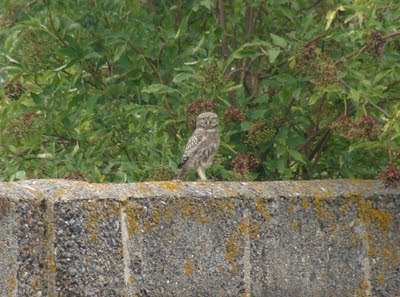 |
| Cliffe Marshes 2020? |
Some things you just can’t ignore.
I was pretty dismayed to read a recent Sunday Times article detailing the latest attempts by airline industry figures to turn a remote area of north Kent into an airport larger in size and scope than Heathrow. These plans seem to have been doing the rounds for years, but while I’m not particularly thrilled at the idea of any airport being built, this one is personal. If it goes ahead, the very spot I am writing this from will be changed forever – instead of a peaceful wilderness (or as much as one is possible in the South East) there will be Boeings passing overhead and the bleak but utterly beautiful marshes that I can see from my window will be smeared in tarmac, oil and dust.
The brain behind this latest proposal is one John Olsen, a retired airline industry executive, who is using the Independent Aviation Advisory group (IAAG) to push through his plans. The article entitled ‘Airport plan that might just fly’ (7.8.11) details his desire to transform Cliffe and the ‘barren stretch of reeds and grass’ upon which it looks, into ‘London Gateway Airport’ – a 15billion, 24hr hub, handling 100million visitors a year. Damn my local Co-op is going to be busy.
The dire need for a new airport apparently stems from the size limitations imposed by Heathrow. There is no room to expand it and thus the UK is lagging behind other European hubs such as Paris and Frankfurt. Not only that, there is a paranoid fear that the UK may miss out on lucrative links with emerging markets in China, India and South America. Of course the Mayor of London, that flop-haired goon in City Hall, is involved too. While his famed plan for ‘Boris Island’ in the Thames might sink, you can bet he’s all over this.
Now on some practical level I can see that this project has evolved from a genuine need. I appreciate that ties to foreign economies need to be strong and sustainable in order to drive our own. The conservation sector is as much reliant on good market conditions as any other. If Heathrow is hindering this and cost/benefit analysis shows a new airport will provide long term relief then so be it. I can even see why the location at Cliffe has been selected; a basic but adaptable travel infrastructure is already in place, there is, technically, space and its ‘gateway’ image undoubtedly has appealing connotations to both business and tourism industries alike. But ultimately I could NEVER support or condone a project that would prove so devastating to a precious landscape.
Y’see, that ‘barren stretch of reeds and grass’ is anything but barren. It’s part of a landscape that has evolved over hundreds of years and its low-lying wetland nature represents a scarce and fragile habitat in the UK. Olsen’s chosen site lies adjacent to areas of significant environmental importance, notably the South Thames Estuary and marshes SSSI and the North Kent Marshes SPA (a designated RAMSAR site). These areas are protected for, among other reasons, their importance as a wintering ground for hundreds of thousands of birds. And then there are the areas beyond immediate sight – parts of Essex, Suffolk and East Kent that would surely experience some negative fall out too. The airport would not only wreak havoc from an ecological standpoint. In only a short time I have realised the Hoo Peninsular has a certain charm; one informed by its rural location and bestowed on the inhabitants whether they realise it or not. A way of life would be lost.
The environmental concerns mentioned above, which were heavily defended by the RSPB and other organisations, played a key part in the rejection of previous plans for the airport at Cliffe by the Department of Transport. But although Olsen is aware he may run into similar opposition once again, it’s totally cool; he’s got the answers! Apparently the airport will ‘attempt to compensate for disruption to natural habitats by including animal and wildflower conservancies, an aviary and extensive woodland’. Yep. I laughed my fucking arse off when I read that. I mean, an extensive woodland – why? How about an extensive grazing marsh? You know, the kind that has been there for centuries. But it’s not all bad news:
This Olsen chap has more great ideas up his sleeve too: ‘There is also a proposal to replicate the Eden Project biodome attraction in Cornwall – it would be called ‘East of Eden’’. *Sigh* He suggests “clusters” of other attractions in the vicinity of the airport such as ‘an aquatics centre, science park and athletics stadium’. Because that over-priced heap of junk we just built in Stratford isn’t enough. The kids, they love their athletics! Shit, we need more stadiums to meet this insatiable demand!
Ok, I’m just fooling around but the point remains; regardless of the perceived benefit, we cannot afford to treat our environment this way. Building an airport requires a lot of land and in a heavily populated region is going to impact the environment in some way. This is not simply a case of NIMBYism on my part, I feel sorry for the people who live on Heathrow’s flight path, it must be hell... but I’m sure there are better options which must be considered.
The article concludes by quoting Olsen as he laments “why is it so hard to convince people to build a new airport?” It’s not the convincing that’s hard, it’s the location. In this case, Cliffe is not it. We stand to lose too much.
 |
| Cliffe Marshes 2011 |
Related articles/websites:
He’s at it again - apparently the bird populations on the peninsula’s west and north are “meagre" and it’s the "best piece of undeveloped land anywhere near any major city in Europe”
Visit RSPB Cliffe Pools and see this wonderful site yourself
Stay up to date http://www.northkentmarshes.org.uk/









